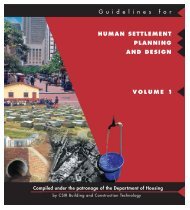Appendices FBAR - CSIR
Appendices FBAR - CSIR
Appendices FBAR - CSIR
Create successful ePaper yourself
Turn your PDF publications into a flip-book with our unique Google optimized e-Paper software.
Appendix H: Pilot plant EMP<br />
THE APPROACH TO THE EMP<br />
A typical EMP takes the planning and design, construction, operational and decommissioning phases of a project into<br />
account. The EMP is compiled as part of the Basic Assessment (BA) process and is an annexure to the project report.<br />
However, owing to the scale of this pilot plant project i.e. the fact that it is a preassembled and temporary facility<br />
determines that the only significant stages of the project that should be guided by this EMP are the planning phase, the<br />
actual laydown or siting of the containers and pipes, the operation of the pilot plants and the removal of the containers<br />
and pipes (decommissioning).<br />
The EMP is based largely on the findings and recommendations of the BA process. However, the EMP is considered a “live”<br />
document and must be updated with additional information or actions during the design, construction and operational<br />
phases.<br />
The EMP follows an approach of identifying an over-arching goal and objectives, accompanied by management actions<br />
that are aimed at achieving these objectives. The management actions are presented in a table format in order to show<br />
the links between the goal and associated objectives, actions, responsibilities, monitoring requirements and targets. The<br />
management plans for the design, construction, operation and decommissioning phases consist of the following<br />
components:<br />
Description of the activity taking place;<br />
The potential impacts associated with that activity;<br />
Significance of the impact prior to mitigation;<br />
The appropriate mitigation measures;<br />
Significance of the impact post-mitigation;<br />
The responsible party; and<br />
Monitoring frequency.<br />
Roles and Responsibilities<br />
For the purposes of the EMP, the generic roles that need to be defined are those of the:<br />
Project Developer<br />
Environmental Control Officer (ECO)<br />
Lead Contractor<br />
Operations Manager.<br />
Note: The specific titles for these functions will vary from project to project. The intent of this section is to give a generic<br />
outline of what these roles typically require.<br />
i. Project Developer<br />
The Project Developer (i.e. SolaireDirect) is the „owner‟ of the project and as such is responsible for ensuring that the<br />
conditions of the environmental authorisation issued in terms of NEMA (should the project receive such authorisation)<br />
are fully satisfied, as well as ensuring that any other necessary permits or licences are obtained and complied with. It is<br />
expected that the Project Developer will appoint the Environmental Control Officer, Construction Manager and the<br />
Operations Manager.<br />
ii. Environmental Control Officer (ECO)<br />
The Environmental Control Officer (ECO) will be responsible for overseeing the implementation of the EMP during the<br />
construction and operations phases, and for monitoring environmental impacts, record-keeping and updating of the<br />
EMP as and when necessary.<br />
During construction, the Environmental Control Officer will be responsible for the following:<br />
Meeting on site with the Construction Manager prior to the commencement of construction activities to<br />
confirm the construction procedure and designated activity zones;

















